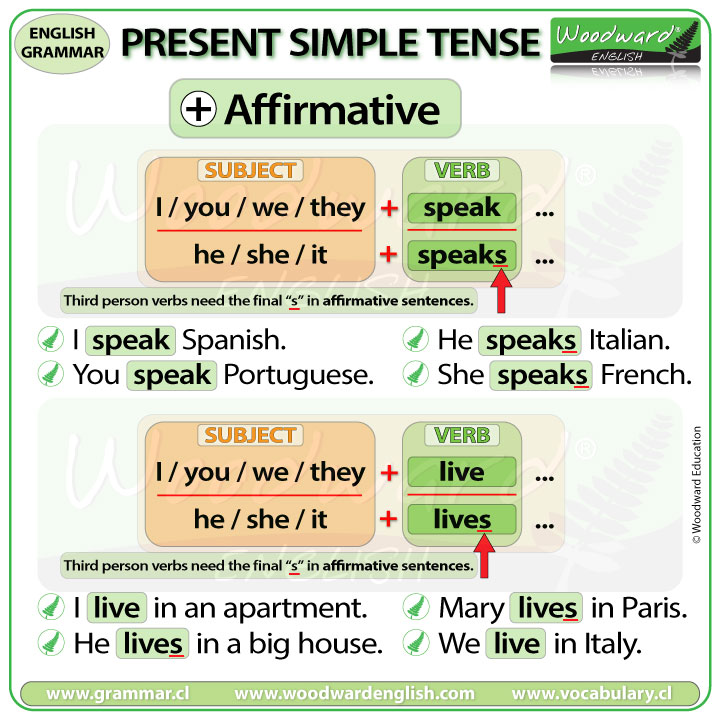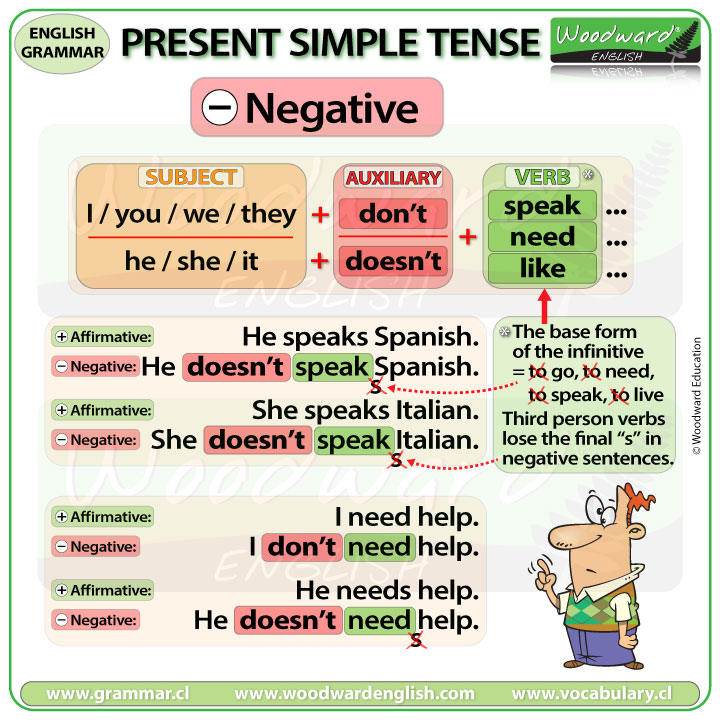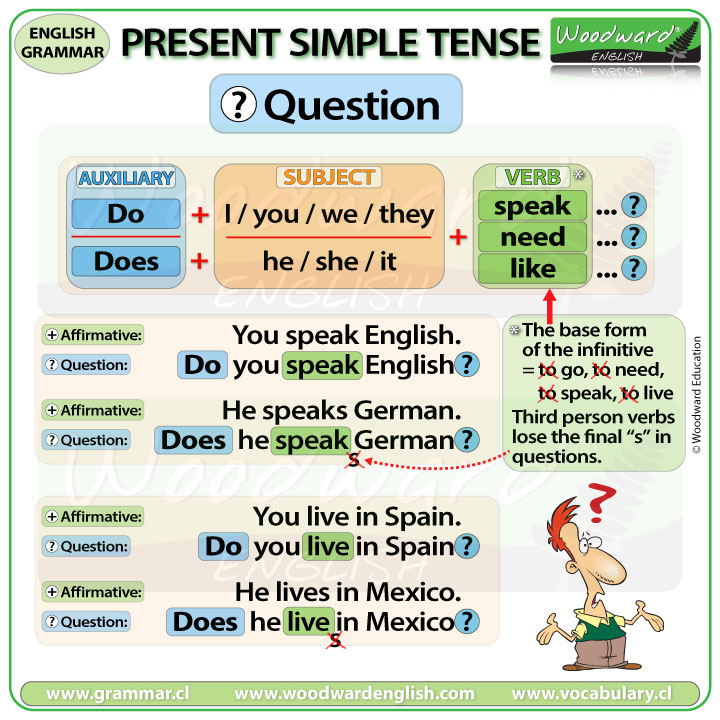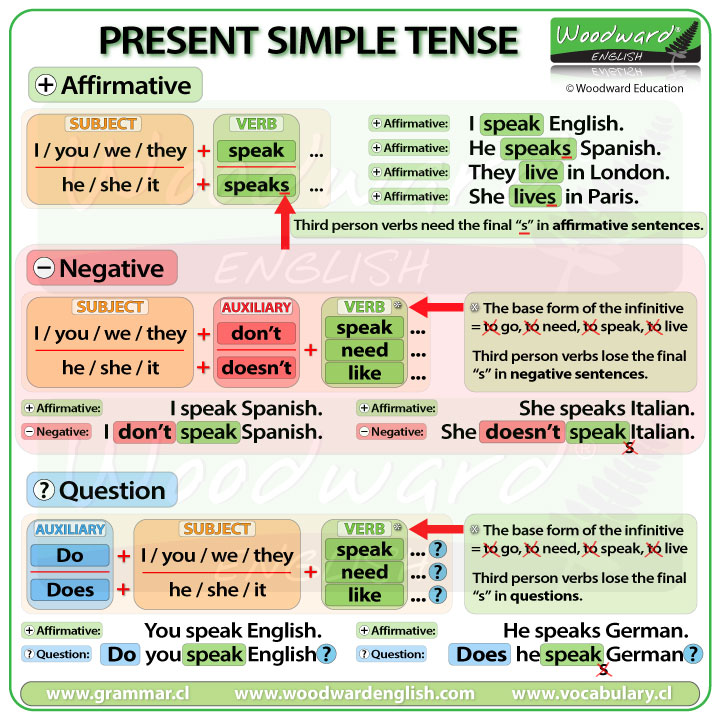Present Simple Tense in English – Easy English Lesson
- I speak English.
“I” is a subject. In general, a person.
“Speak” is a verb. In general, an action.
You can change the subject. For example:
- You speak English
- We speak English
- They speak English
BUT, sometimes the verb changes. We say:
- I speak …
- You speak …
- We speak …
- They speak …
BUT, For He / She / It we use SPEAKS with an S at the end.
The S is necessary at the end of a verb when the subject is HE, SHE, or IT.
- He speaks…
- She speaks…
- It speaks…
Look at these examples:
- I speak Spanish.
- You speak Portuguese.
But…
- He speaks Italian.
The S is necessary at the end of the verb.
You cannot say:
- He speak Italian …. (No, this is NOT correct)
We need an S at the end of the verb. We say:
- He speaks Italian. (This is correct)
Another example:
- She speaks four languages.
English is a language, Spanish is a language, Portuguese is a language, Italian is a language.
- She speaks four languages.
Again, the S is necessary at the end of speak.
Let’s look at another verb. We say:
- I live …
- You live …
- We live …
- They live …
BUT, for He / She / It we use LIVES with an S at the end.
The S is necessary at the end of a verb when the subject is HE, SHE, or IT.
- He lives …
- She lives …
- It lives …
Look at these examples:
- I live in a small apartment.
- He lives in a big house.
LIVES with an S at the end because HE lives.
Now look at this sentence:
- Mary lives in Paris.
Why do we use LIVES?
Because Mary is SHE.
- SHE lives in Paris.
One more example:
- We live in … New Zealand.

Sometimes the verb changes a little for HE, SHE and IT (third person).
Look at this verb: HAVE
We say:
- I have …
- You have …
- We have …
- They have …
BUT, for He / She / It we use HAS.
We do NOT say Haves… because the verb is irregular.
Look at these examples:
- I have a good idea.
- You have black hair.
- She has a dictionary.
- John has blue eyes.
We will learn more about these types of third person changes in another lesson.
Negative Sentences – Present Simple Tense
Look at this sentence:
- They speak English.
This is an affirmative sentence.
How can I make this a NEGATIVE sentence?
In English, we use don’t and doesn’t to make a negative sentence in present simple tense.*
- They speak English. … becomes …
- They don’t speak English.
Don’t shows that the sentence is negative.
We don’t say:
- They no speak English. (No, this is NOT correct)
We say:
- They don’t speak English. (Yes, this is CORRECT)
Note: We use don’t and doesn’t to make a negative sentence in the present simple tense.
* Exceptions: Negative sentences that use To Be or Modal Verbs (can, might, must, etc.)
What is the difference between DON’T and DOESN’T?
Look at this chart:

When the subject is I, YOU, WE or THEY … we use don’t before the verb.
When the subject is HE, SHE or IT … we use doesn’t before the verb.
DON’T is a contraction of DO NOT.
DOESN’T is a contraction of DOES NOT.
After don’t and doesn’t we have a VERB.
This verb is the base form of the infinitive.
The infinitive is the original form of the verb before it is conjugated or changed.
The infinitive is to go, to need, to speak, to live.
But we want the BASE form of the infinitive… this is without the TO at the beginning.
- Instead of TO GO, only GO.
- instead of TO NEED, only NEED.
- Instead of TO SPEAK, only SPEAK.
- Instead of TO LIVE, only LIVE.
Let’s look at the example of the verb SPEAK. We say:
- I don’t speak …
- You don’t speak …
- We don’t speak …
- They don’t speak …
For example, the affirmative:
- I speak Spanish.
What is the negative form?
The negative is:
- I don’t speak Spanish.
Another example: The affirmative:
- We speak Italian.
What is the negative form?
The negative is:
- We don’t speak Italian.
BUT, look at this affirmative sentence:
- He speaks Spanish.
What is the negative form of this sentence?
- He doesn’t speak Spanish.
There is NO S at the end of ‘speak’ in the negative sentence. Why?
We use the base form of the infinitive. The infinitive is TO SPEAK, we just want the base form, which is SPEAK.
Third person verbs lose the final S in negative sentences.
- I don’t speak …
- He doesn’t speak …
The verb in negative form will always be SPEAK without an S.
Let’s look at another example:
- She speaks Italian.
What is the negative form of this sentence?
- She doesn’t speak Italian.
Again, there is NO S at the end of ‘speak’ in the negative sentence.
Let’s look at another verb: NEED.
The affirmative sentence is:
- I need help.
What is the negative form of this sentence?
- I don’t need help.
And this affirmative sentence:
- He needs help.
We need the S at the end for the third person in affirmative sentences.
What is the negative form of this sentence?
- He doesn’t need help.
Again, no S at the end of the verb because it is a negative sentence.
Let’s look at another verb: LIKE.
The affirmative sentence is:
- I like football.
What is the negative form of this sentence?
- I don’t like football.
And this affirmative sentence:
- He likes football.
We need the S at the end for the third person in affirmative sentences.
What is the negative form of this sentence?
- He doesn’t like football.
Again, no S at the end of the verb because it is a negative sentence.
Questions – Present Simple Tense
Look at this sentence.
- You speak English.
This is an affirmative sentence. What is the question?
- DO you speak English?
In English, we use DO and DOES to make questions in present simple tense.*
* Exceptions: Questions that have To Be or Modal Verbs (can, might, must, etc.)
- You speak English. (Affirmative sentence)
- Do you speak English? (Question)
The word DO at the beginning tells us it is a question.
Look at the chart:

Do is used for questions with I, you, we, and they.
Does is used for questions with he, she, and it.
Also the same rules apply to the verb in questions.
We use the base form of the infinitive.
For example, the affirmative sentence:
- He speaks German.
There is an S at the end of speaks because the subject is HE and it is an affirmative sentence.
What is the question?
- Does he speak German?
No S at the end of speak because we need to base form of the infinitive.
Another example:
- You live in Spain.
This is an affirmative sentence.
How can we change this to a question?
- Do you live in Spain?
The DO tells us it is a question.
Another affirmative sentence:
- He lives in Mexico.
Notice the S at the end of lives because the subject is HE and it is an affirmative sentence.
How can we change this to a question?
- Does he live in Mexico?
No S at the end of live because we need to base form of the infinitive.
Present Simple Tense – Summary Chart

I hope you found this English lesson about the Present Simple Tense useful.
If you did, please let other people know about this lesson.
